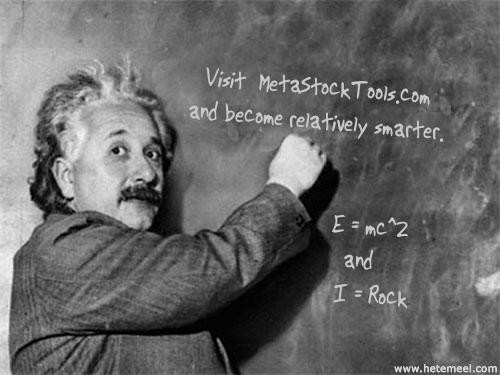Einstein s Stock Tips Gravity and Growth
Post on: 7 Май, 2015 No Comment

Albert Einstein changed the universe from a mechanical construct where all things follow a set of static rules to a place where everything, including time and space, is bent by relativity. Although the theory of relativity is important in the study of physics, it also offers an interesting view into the world of investing. This article will use some of Einstein’s main discoveries to gain some perspective on the problem of telling real growth from irrational pricing.
Determining True Value
This theoretical situation is easily extended to the stock market. If we imagine gravity as the true value of a stock (or the true worth of the company it represents) and the rocket as a shooting star (a stock with a value that quickly inflates without reference to the value of the underlying company) we can apply relativity to tell the difference.
One of the biggest challenges is trying to remove yourself from the market in order to see both the rockets and the heavenly bodies. One of the places investors should search is the balance sheet. The balance sheet can be used to compare the stock price relative to its earnings per share (EPS) and examine whether the price is justified by its price-to-book ratio (P/B ratio), or is just based on analyst enthusiasm. (For related reading, see Clone Cost Reveals True Value .)
Mass Vs. Fuel
In order for a heavenly body to increase the amount of gravity it exerts, it has to increase in mass. The same is true for stocks; companies must expand in order to increase in value. This can be done by adding mass in the form of acquisitions and expansion into new markets. An increase in gravity can also be achieved by restructuring inefficient areas in the company. (For more, see Cashing In On Corporate Restructuring .)
Care must be taken when selecting what mass to add. The assets must have good density in that they already have reasonably good cost/gain ratios and that they will fit into the makeup of the company. When building a successful company, you need compatible components. We will look at compatible mass when considering the opposite of a heavenly body.
A rocket, or a stock that has detached from the value of the company and is accelerating, may take acquisitions, but the acquisitions merely provide fuel to the acceleration. This often happens when the management of the company realizes its stock — and the company — is going to crash. The company will act aggressively in order to nurture the impression that it is growing in leaps and bounds, but the acquisitions are often zombies. (For more insight on crashes, read Bouncing Back From A Portfolio Hit .)
Sometimes, this sleight of hand is easily revealed, for example, when a company begins buying assets completely unrelated to its business model. Because these assets aren’t compatible with its basic business model, they merely serve as fuel to inflame public perceptions about the value of the stock and the direction of the company. This can also be seen in investment funds that jump late into strong performers in order to appear aggressive before quarterly earnings come out.
Velocity, Time and Risk
However, when timing stocks, the risk is difficult to calculate. If a stock takes off at Point A and will crash at Point B, properly timing it in order to profit will be difficult because its crash can be caused by random elements, such as an industry rumor or other noise. Additionally, like a rocket, an unstable stock has a velocity. Velocity has a warping affect on time – the more velocity something has, the larger the impact it has on the passage of time.
In terms of trying to trade at the top of a stock’s rise, the faster a stock gains value, the smaller the margin of error becomes. Consequently, the time to make such a decision is shortened exponentially. So, breakneck velocity combined with uncertainty of the endpoint makes a rapid and fatal ride for most investors.
Conclusion
The theory of relativity is an odd place to look for advice on investing, but by framing investing problems in new ways, we can sometimes see things that were closed to us before. Physicist and investors share the common problem of making accurate observations in a world that refuses to sit still and wait.














